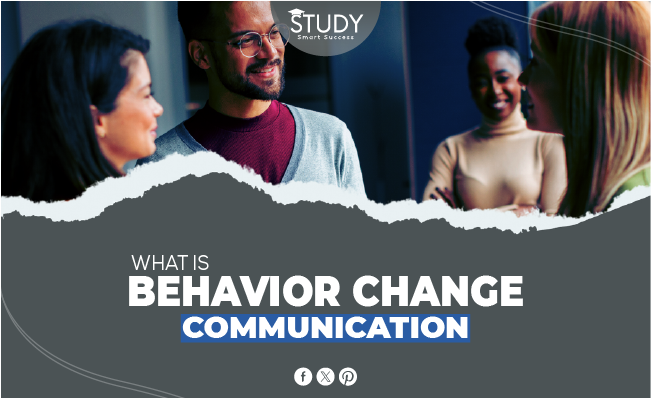Tactics that change how people and groups act are necessary to make public health measures work. Behavior Change Communication (BCC) is one critical strategy. BCC is a way to write and send messages that encourage healthy habits and good health results, and it is based on proof.
Understanding Behavior Change Communication
Changes in behavior Communication means tailoring messages to the people you want to reach and using different types of communication to get those messages across. This approach is based on understanding how psychological, social, and environmental factors affect behavior. The end goal is to encourage long-lasting changes in behavior that make everyone healthier.
Critical Components of Behavior Change Communication
- Audience Analysis involves analyzing the target audience’s demographics, psychographics, and behavior, including their goals, attitudes, and beliefs.
- Message Development: Clear, relevant, and captivating messaging. Messages should match the audience’s values and culture.
- Media Selection: Select the best audience-reaching channels. Examples include mass media, internet platforms, community outreach, and interpersonal communication.
- Implementation: Coordinating campaigns and actions to implement the communication strategy.
- Evaluation: Monitoring and analyzing behavior change from communication activities. Feedback and findings inform adjustments.
Case Studies of Successful Behavior Change Communication
The ABC HIV Prevention Campaign in Uganda
Uganda’s ABC (Abstinence, Be faithful, use Condoms) program is an excellent example of BCC. The HIV/AIDS campaign promoted safer sexual behaviors via mass media, community mobilization, and interpersonal communication. Well-coordinated BCC reduced HIV prevalence rates significantly.
The Handwashing Initiative in Bangladesh
BCC campaigns in Bangladesh promoted soap washing to minimize diarrheal illnesses. The initiative promoted itself via TV ads, community seminars, and school events. Public health improved as handwashing increased due to the effort.
Anti-Smoking Campaign in Australia
Australia’s National Tobacco Campaign reduced smoking rates via Behavior Change Communication. Sharp ads highlighted smoking’s health risks, support services were available for smokers, and plain cigarette packaging was used. Community outreach and television, radio, and internet media were also used in the campaign. The comprehensive plan raised public knowledge of smoking’s risks and offered services for smokers who wanted to stop, reducing smoking prevalence.
Promoting Breastfeeding in Brazil
The Brazilian Ministry of Health promoted breastfeeding among new moms with a BCC campaign. The project taught women about the health advantages of breastfeeding for newborns and mothers and the significance of exclusive breastfeeding for six months. The campaign reached its audience via TV ads, social media, and healthcare facility education—our culturally appropriate messaging aligned with local norms and practices, increasing breastfeeding rates and improving baby health.
The Importance of Behavior Change Communication
BCC is essential to public health initiatives because it promotes permanent behavioral changes that enhance health outcomes. With focused messages, targeted communication channels, and continual assessment, BCC may affect behavior and encourage healthy choices. It addresses social, cultural, and environmental barriers to behavior change to bridge the knowledge-action gap. Behavior Change Communication is essential for lasting public health changes. BCC is crucial to every effective public health campaign and promotes healthy habits globally. Let’s keep using this effective method to improve people and civilizations.
Let’s keep using this effective method to improve people and civilizations. Understanding BCC, learning from successful case studies, and acknowledging its value in public health initiatives may help us promote healthier habits and well-being. Even though habit change is complex, we can build a healthier, happier society for ourselves and future generations with the correct tools and techniques. Let’s continue using behavior change communication in public health and work toward positive behavior change. Remember, every little bit helps improve tomorrow.
Challenges and Considerations in Behavior Change Communication
BCC has many successes, but it also has drawbacks. Cultural sensitivity and relevance are significant obstacles. Ineffective messages may not match the target audience’s cultural norms. Addressing disinformation and challenging long-held views requires persistence and good planning. Budgetary restrictions and infrastructural issues also hinder BCC efforts. Despite these limitations, deliberate and intelligent Behavior Change Communication may advance global public health programs.
Best Practices for Effective Behavior Change Communication
- Research and Evidence: Use research to support your claims. Know the behaviors you want to modify and their context.
- Cultural Sensitivity: Keep your messaging culturally suitable. What works in one culture may not work in another.
- Multi-Channel Approach: Communicate with your audience via numerous channels. A multifaceted approach works best since individuals receive information differently.
- Engagement and Participation: Involve the community. Target audience participation improves message relevancy and acceptability.
- Sustainability: Prioritize long-term habit change above short-term advantages. Strategies should be long-lasting.
Challenges in Behavior Change Communication
Despite its effectiveness, BCC faces several challenges. These include:
- Resistance to Change: People may resist altering habits even when they see the advantages.
- Resource Limitations: Comprehensive BCC campaigns need resources.
- Measuring Impact: BCC’s direct influence on behavior change is hard to assess due to impacting circumstances.
- Message Clarity: Keep communications simple. Complex communications confuse audiences and diminish communication efficacy.
- Feedback Mechanisms: Use feedback to enhance the communication approach. Sharing audience views and experiences may improve the campaign’s efficacy.
- Leveraging Technology: Increase your reach using technology and digital channels. Social media, smartphone apps, and other digital technologies may spread messages and engage audiences.
- Partnerships and Collaborations: Partner with local groups, influencers, and stakeholders. BCC activities gain credibility and reach via collaboration.
- Continuous Monitoring and Evaluation: Monitor and evaluate the campaign’s effect to make modifications and improvements.
- Addressing Barriers: Identify and overcome economic, environmental, and psychological obstacles to behavior change. Interventions tailored to these obstacles may improve success.
- Inclusivity: For equitable health results, make BCC inclusive and reflect the needs of all groups, particularly disadvantaged and vulnerable populations.
The Future of Behavior Change Communication
BCC’s future is bright as technology and new media provide new ways to engage consumers. Modern technology may improve BCC via mHealth, social media, and digital storytelling. Behavioral economics and data analytics may also reveal behavior trends, improving communication tactics.
Conclusion
Changes in behavior: Communication is one of the most critical skills public health workers need. Understanding and using BCC’s concepts well can encourage better habits and improve health results worldwide. The goal is the same, whether it’s community-based programs or ads in the media: to get people to change their behavior in a way that is good for everyone and improves public health.


